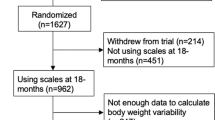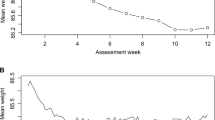Abstract
Background/Objectives
Positive associations have been found between adherence and weight loss in behavioral weight-management interventions. However, less attention has been given to the level of adherence needed to reach clinically significant weight loss. This study examined the levels of adherence associated with a ≥ 5% – < 10% or ≥ 10% weight loss in a community-based, intensive behavioral weight management program, Weight Watchers® (WW), which included three modes of access: (1) 24-weekly WW meetings over 6 months, (2) the WW member website, and (3) the WW mobile application.
Methods
A total of 292 participants were randomized to a WW (n = 147) or a self-help (SH) (n = 145) condition. To assess the impact of adherence, only participants in the WW condition were included in analyses (n = 147). Adherence was defined as use of the three modes of access. Measured heights and weights were obtained at baseline and 6 months. Receiver-operating characteristic curve analyses were conducted to determine the minimal level of adherence associated with clinically significant weight loss.
Results
In a 6-month period, increased likelihood of achieving a weight loss ≥ 5% – < 10% was associated with attending approximately one-third (35.4%) of weekly meetings, use of the member website about 25% of days, and use of the mobile application 16.1% of days. Attendance at approximately two-thirds (64.5%) of meetings, use of the member website 41.6% of days, and use of the mobile application 14.7% of days were associated with a clinically significant weight loss of ≥ 10%. Meeting attendance was the strongest predictor of weight loss at 6 months.
Conclusions
Although adherence to a behavioral weight management program was an important predictor of weight loss, extremely high levels were not needed to achieve clinically significant weight loss. These results are important to help patients and treatment providers understand realistic goals for weight management.
This is a preview of subscription content, access via your institution
Access options
Subscribe to this journal
Receive 12 print issues and online access
$259.00 per year
only $21.58 per issue
Buy this article
- Purchase on Springer Link
- Instant access to full article PDF
Prices may be subject to local taxes which are calculated during checkout


Similar content being viewed by others
References
Popkin BM, Adair LS, Ng SW. Global nutrition transition and the pandemic of obesity in developing countries. Nutr Rev. 2012;70:3–21.
Alhassan S, Kim S, Bersamin A, King A, Gardner C. Dietary adherence and weight loss success among overweight women: results from the A TO Z weight loss study. Int J Obes. 2008;32:985–91.
Phelan S, Wyatt HR, Hill JO, Wing RR. Are the eating and exercise habits of successful weight losers changing? Obesity. 2006;14:710–6.
Wadden TA, Neiberg RH, Wing RR, Clark JM, Delahanty LM, Hill JO, et al. Four-year weight losses in the Look AHEAD study: factors associated with long-term success. Obesity. 2011;19:1987–98.
Wadden TA, West DS, Neiberg RH, Wing RR, Ryan DH, Johnson KC, et al. One‐year weight losses in the Look AHEAD Study: factors associated with success. Obesity. 2009;17:713–22.
Wing RR, Papandonatos G, Fava JL, Gorin AA, Phelan S, McCaffery J, et al. Maintaining large weight losses: the role of behavioral and psychological factors. J Consult Clin Psychol. 2008;76:1015.
Bartfield JK, Stevens VJ, Jerome GJ, Batch BC, Kennedy BM, Vollmer WM, et al. Behavioral transitions and weight change patterns within the PREMIER trial. Obesity. 2011;19:1609–15.
Hollis JF, Gullion CM, Stevens VJ, Brantley PJ, Appel LJ, Ard JD, et al. Weight loss during the intensive intervention phase of the weight-loss maintenance trial. Am J Prev Med. 2008;35:118–26.
Look AHEAD Research Group. Eight-year weight losses with an intensive lifestyle intervention: the Look AHEAD study. Obesity. 2014;22:5–13.
Acharya SD, Elci OU, Sereika SM, Music E, Styn MA, Turk MW, et al. Adherence to a behavioral weight loss treatment program enhances weight loss and improvements in biomarkers. Patient Prefer Adherence. 2009;3:151–60.
Burke LE, Wang J, Sevick MA. Self-monitoring in weight loss: a systematic review of the literature. J Am Diet Assoc. 2011;111:92–102.
Klem ML, Wing RR, McGuire MT, Seagle HM, Hill JO. A descriptive study of individuals successful at long-term maintenance of substantial weight loss. Am J Clin Nutr. 1997;66:239–46.
McGuire MT, Wing RR, Hill JO. The prevalence of weight loss maintenance among American adults. Int J Obes Relat Metab Disord. 1999;23:1314–9.
Weiss EC, Galuska DA, Kettel Khan L, Gillespie C, Serdula MK. Weight regain in U.S. adults who experienced substantial weight loss, 1999-2002. Am J Prev Med. 2007;33:34–40.
Fuertes JN, Mislowack A, Bennett J, Paul L, Gilbert TC, Fontan G, et al. The physician-patient working alliance. Patient Educ Couns. 2007;66:29–36.
Jensen MD, Ryan DH, Apovian CM, Ard JD, Comuzzie AG, Donato KA, et al. 2013 AHA/ACC/TOS guideline for the management of overweight and obesity in adults: a report of the American College of Cardiology/American Heart Association Task Force on Practice Guidelines and The Obesity Society. Circulation. 2014;129(25Suppl 2):S102–38.
Magkos F, Fraterrigo G, Yoshino J, Luecking C, Kirbach K, Kelly SC, et al. Effects of moderate and subsequent progressive weight loss on metabolic function and adipose tissue biology in humans with obesity. Cell Metab. 2016;23:591–601.
Blackburn G. Effect of degree of weight loss on health benefits. Obes Res. 1995;3(Suppl 2):211s–6s.
Tuomilehto H, Seppa J, Uusitupa M, Peltonen M, Martikainen T, Sahlman J, et al. The impact of weight reduction in the prevention of the progression of obstructive sleep apnea: an explanatory analysis of a 5-year observational follow-up trial. Sleep Med. 2014;15:329–35.
Alfaris N, Wadden TA, Sarwer DB, Diwald L, Volger S, Hong P, et al. Effects of a 2-year behavioral weight loss intervention on sleep and mood in obese individuals treated in primary care practice. Obesity. 2015;23:558–64.
Wolin KY, Carson K, Colditz GA. Obesity and cancer. Oncologist. 2010;15:556–65.
Pan XR, Li GW, Hu YH, Wang JX, Yang WY, An ZX, et al. Effects of diet and exercise in preventing NIDDM in people with impaired glucose tolerance. The Da Qing IGT and Diabetes Study. Diabetes Care. 1997;20:537–44.
Knowler WC, Barrett-Connor E, Fowler SE, Hamman RF, Lachin JM, Walker EA, et al. Reduction in the incidence of type 2 diabetes with lifestyle intervention or metformin. New Engl J Med. 2002;346:393–403.
Tuomilehto J, Lindstrom J, Eriksson JG, Valle TT, Hamalainen H, Ilanne-Parikka P, et al. Prevention of type 2 diabetes mellitus by changes in lifestyle among subjects with impaired glucose tolerance. New Engl J Med. 2001;344:1343–50.
Wilson PW, Kannel WB, Silbershatz H, D’Agostino RB. Clustering of metabolic factors and coronary heart disease. Arch Intern Med. 1999;159:1104–9.
Jensen MD, Ryan DH, Apovian CM, Ard JD, Comuzzie AG, Donato KA, et al. 2013 AHA/ACC/TOS Guideline for the management of overweight and obesity in adults: a report of the American College of Cardiology/American Heart Association Task Force on Practice Guidelines and The Obesity Society. J Am Coll Cardiol. 2014;63(25 Pt B):2985–3023.
Johnston CA, Rost S, Miller-Kovach K, Moreno JP, Foreyt JP. A randomized controlled trial of a community-based behavioral counseling program. Am J Med. 2013;126:1143.e19–24.
Pintea S, Moldovan R. The receiver-operating characteristic (ROC) analysis: Fundamentals and applications in clinical psychology. J Cogn Behav Psychother. 2009;9:49–66.
Kiernan M, King AC, Kraemer HC, Stefanick ML, Killen JD. Characteristics of successful and unsuccessful dieters: an application of signal detection methodology. Ann Behav Med. 1998;20:1–6.
Pasman WJ, Saris WH, Westerterp-Plantenga MS. Predictors of weight maintenance. Obes Res. 1999;7:43–50.
Teixeira PJ, Going SB, Houtkooper LB, Cussler EC, Metcalfe LL, Blew RM, et al. Pretreatment predictors of attrition and successful weight management in women. Int J Obes Relat Metab Disord. 2004;28:1124–33.
Foster GD, Wadden TA, Kendall PC, Stunkard AJ, Vogt RA. Psychological effects of weight loss and regain: a prospective evaluation. J Consult Clin Psychol. 1996;64:752–3.
Latner JD, Ciao AC. Weight-loss history as a predictor of obesity treatment outcome: prospective, long-term results from behavioral, group self-help treatment. J Health Psychol. 2014;19:253–61.
Eugeni ML, Baxter M, Mama SK, Lee RE. Disconnections of African American public housing residents: connections to physical activity, dietary habits and obesity. Am J Community Psychol. 2011;47:264–76.
Drewnowski A, Specter S. Poverty and obesity: the role of energy density and energy costs. Am J Clin Nutr. 2004;79:6–16.
Timmins CL. The impact of language barriers on the health care of Latinos in the United States: a review of the literature and guidelines for practice. J Midwifery Women’s Health. 2002;47:80–96.
Smith JC, Medalia C Heath Insurance Coverage in the United States: 2014. 2015; https://www.census.gov/content/dam/Census/library/publications/2015/demo/p60-253.pdf. Accessed 27 December 2015.
Acknowledgements
This study was sponsored by Weight Watchers International, Inc. The funding source reviewed and approved the design of the study and the final manuscript.
Author information
Authors and Affiliations
Corresponding author
Ethics declarations
Conflict of interest
ACW and GDF are employees of Weight Watchers International, Inc. CAJ, JPM, and JPF received research support from Weight Watchers International, Inc. DCH, BAL, and TAC declare no conflicts of interest.
Rights and permissions
About this article
Cite this article
Johnston, C.A., Moreno, J.P., Hernandez, D.C. et al. Levels of adherence needed to achieve significant weight loss. Int J Obes 43, 125–131 (2019). https://doi.org/10.1038/s41366-018-0226-7
Received:
Revised:
Accepted:
Published:
Issue Date:
DOI: https://doi.org/10.1038/s41366-018-0226-7
This article is cited by
-
The impact of participant mental health on attendance and engagement in a trial of behavioural weight management programmes: secondary analysis of the WRAP randomised controlled trial
International Journal of Behavioral Nutrition and Physical Activity (2021)



